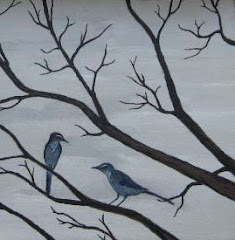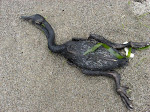
Last week, with our respective busy seasons behind us, Sarah and I took our annual end-of-summer vacation. We spent seven days exploring the east side of Vancouver Island, British Columbia. The Island's east side has much milder weather and calmer seas that the west side, which more closely resembles the Oregon coast. We were therefore able to explore territory different from what we are used to.

We began the trip on a large ferry from Port Angeles, Washington to Victoria, BC. As the ferry crossed the Straight of Georgia, we found four species of sea bird that were new to us: Sooty Shearwater, Pink-footed Shearwater, Parasitic Jager, and Pomarine Jager. A great start to the week!

We spent two nights in Victoria, above, then drove north to the fishing community of Campbell River.

Along one of the river's tributaries, the air smelled strongly of rotting salmon and the stream boiled with pink salmon waiting their turn to enter a hatchery.

The tall humps of the males stuck out of the water as they fought the current. Glaucous-winged gulls, Turkey Vultures, and Common Ravens waited above to clean up the fish whose life cycles were completed.

Our motel room in Campbell River looked over the Discovery Passage, a narrow body of water separating Vancouver Island from other islands and the BC mainland.

While watching the passage, we spotted mainy birds, including the migrating Bonaparte's Gulls above. We also saw a small group of orcas and plenty of fishing boats, yaughts, and cruise ships.

The tide pooling near our motel was great as well.

A few meters from our room, we had access to a cobly beach full of sea creatures at low tide.

In addition to crabs, we found many sunflower stars, which are multi-rayed, voracious predators of other aquatic invertebrates.

Though they look pretty much dead at low tide, sunflower stars move a lot faster than the more familiar five-rayed seastars.

The sunflower stars came in a variety of colors including purple, orange, and a combination of the two.

We spent our last two nights in Canada at a great bed and breakfast, also in proximity to a beach. We enjoyed a few picnic dinners while keeping an eye on the straight. We returned to Oregon Saturday afternoon, eager to get back to our usual routines.


 I need to put in an order for woolly gloves.
I need to put in an order for woolly gloves. Our tomato crop is winding down, but our freezer is full of sauce. We are just about ready to eat well during the soggy winter months.
Our tomato crop is winding down, but our freezer is full of sauce. We are just about ready to eat well during the soggy winter months.























































